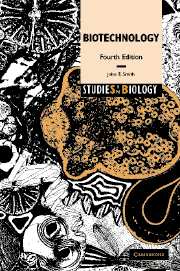Book contents
- Frontmatter
- Contents
- Preface
- 1 The nature of biotechnology
- 2 Substrates for biotechnology
- 3 Genetics and biotechnology
- 4 Bioprocess/fermentation technology
- 5 Enzyme technology
- 6 Biological fuel generation
- 7 Single cell protein (SCP)
- 8 Biotechnology and medicine
- 9 Environmental biotechnology
- 10 Biotechnology in the agricultural and forestry industries
- 11 Food and beverage biotechnology
- 12 Protection of biotechnological inventions
- 13 Safety in biotechnology
- 14 Public perception of biotechnology: genetic engineering – safety, social, moral and ethical considerations
- 15 Looking to the future
- Glossary
- Further reading
- Index
11 - Food and beverage biotechnology
Published online by Cambridge University Press: 05 June 2012
- Frontmatter
- Contents
- Preface
- 1 The nature of biotechnology
- 2 Substrates for biotechnology
- 3 Genetics and biotechnology
- 4 Bioprocess/fermentation technology
- 5 Enzyme technology
- 6 Biological fuel generation
- 7 Single cell protein (SCP)
- 8 Biotechnology and medicine
- 9 Environmental biotechnology
- 10 Biotechnology in the agricultural and forestry industries
- 11 Food and beverage biotechnology
- 12 Protection of biotechnological inventions
- 13 Safety in biotechnology
- 14 Public perception of biotechnology: genetic engineering – safety, social, moral and ethical considerations
- 15 Looking to the future
- Glossary
- Further reading
- Index
Summary
Introduction
Food production is the largest worldwide industry and, in industrialised nations, the expenditure on food can account for at least 20–30% of household budgets. The food industry has evolved through specialist trades or occupations, e.g. butchers, bakers and confectioners, to national and multinational organisations involved in the manufacture and distribution of food on a worldwide scale. With the improvement in means of transportation, foods are available on a worldwide basis and developments in food preservation methods give independence for seasonal availability.
In essence, the food industry now serves the function of supplying society with high-quality, wholesome foods all the year round, and at a distance – in time and location – from the place of primary production.
The food chain has its origins in production agriculture, with the planting of the seed or the rearing of animals, and concludes with the utilisation of the food products by the consumer. Apart from fruits and vegetables, most raw food materials, e.g. cereals and meats, will require some degree of processing. The link between the products of the farm and the consumer is the food processing industry, whereby relatively bulky, perishable, raw agricultural products are transformed into shelf-stable, convenient and palatable foods and beverages.
- Type
- Chapter
- Information
- Biotechnology , pp. 204 - 228Publisher: Cambridge University PressPrint publication year: 2004



